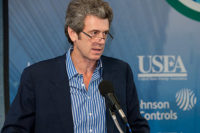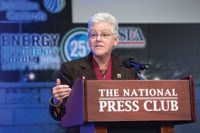
The event, which is sponsored by the United States Energy Association and Johnson Controls, brought in several government leaders to address the crowd, including Christine Whitman, Administrator of the U.S. Environmental Protection Agency (EPA), and Spencer Abraham, Secretary of Energy at the U.S. Department of Energy (DOE).
Whitman, the leadoff speaker, stated, “America’s energy future is brighter today than a year ago.” She said that progress has been made without expense to the environment. “Economic prosperity can go hand-in-hand” with protecting the nation’s environment, she said.
Whitman discussed the success of the Energy Star® program, which encourages companies to “look for more energy-efficient ways to do business.” Last year alone, she said, “Americans, with the help of Energy Star, saved $5 billion on their energy bills and reduced pollution equivalent to that of 10 million cars.”
She noted that more than 10,000 buildings have benchmarked their facilities using the program, and more than 800 have earned the Energy Star rating.
Whitman then announced the expansion of the Energy Star program to include hotels. Now, hotels can benchmark their energy performance against others on a nationwide scale of 1 to 100. She recognized the first two hotels in the United States to receive the energy performance label. They are the Courtyard Indianapolis Capital, owned by White Lodging Services Corp., and the Sheraton Boston Hotel, owned by Starwood Hotels and Resorts Worldwide.
She pointed out that, if the hotel industry reduced its energy usage by 10%, it would be equivalent to the energy required to run 1 million hair dryers for an hour a day for 10 years.
Whitman also announced that the EPA is expanding Energy Star to manufacturing plants.
In addition, she briefly discussed the Bush administration’s program to voluntarily reduce greenhouse gas emissions through economic incentives. “You can see good business practices grow out of good environmental practices,” she said.

SUSTAINABLE ENERGY PLAN
Some say a long-term sustainable energy plan isn’t possible, declared Representative Tom Udall (D-NM). “I disagree,” he countered.“For a while the California energy crisis got our attention,” he said. But that is “only the tip of the iceberg.”
Today, the U.S. imports 53% of the oil we need, said Udall. By 2020, imported oil will constitute 62% if we continue at the same pace. However, “Increased domestic production is not the solution,” he asserted. The U.S. only has 3% of the world’s petroleum reserves, he stated.
The solution, according to Udall, is to:
1. Maximize efficiency and conservation, and
2. Find new sources of energy.
Energy efficiency means “getting more energy for less,” commented Udall. “Investment in renewable energy is another proven method.” The cost of solar energy has dropped 90% since the 1970s, he said. “With a little encouragement, wind energy could become economically viable.”
Realistic targets and goals can be set with as little interference from the federal government as possible, he remarked.
SAVED ENERGY SAVES MONEY
Since Sept. 11, said Representative Mark Udall (D-CO), “Energy security has to be seen in a much broader sense.”Support for energy-efficiency measures has been bipartisan, he noted — saved energy can help lower prices. But both the House and Senate energy bills that were recently passed are “somewhat disappointing,” he opined. The best parts, he said, are the economic incentives for efficiency and for the use of things like fuel cells. A provision for high-performance school buildings is also included.
The two bills fall short, he stated, regarding vehicle fuel economy. Also, both bills failed to address implementation of the higher 13 SEER (seasonal energy efficiency ratio) standard for central air conditioners and heat pumps, which could have saved over $1 billion annually for consumers, he said.
The bills are now headed for a House-Senate conference committee to work out the differences and come up with final energy legislation.
INTEGRATING POLICIES
Also because of Sept. 11, affirmed Senator Chuck Hagel (R-NE), “We’re going to have to integrate policies,” both domestic and international.Over the years, the DOE has “meandered about,” he said. It’s had some definition, then no definition, he claimed. Abraham, on the other hand, said Hagel, is doing a “terrific job” in providing direction.
In debating the energy issue, “Energy efficiency and conservation are very important components,” he related. “But the missing piece is production.
“We need a proportional balance,” he stated. “Before we charge off on an environmental steed and go after producers,” we need to consider all the factors involved. There is nothing more important than energy to factor into our domestic and international policies, he said.
He said the U.S. needs to integrate “the three E’s” — energy, economic, and environmental interests. Energy is central to productivity and it affects the lives of everyone in the world, he observed. “If we take any limited approach, we will fail.”
ENERGY POLICY PROGRESS
Keynote speaker Abraham concluded the day by highlighting the progress that has been made in implementing the president’s national energy policy.Most of the 105 recommendations in this policy could be handled through administrative action, he said, and “We have either completed or are well on our way to completing over three-quarters of them.”
There were 22 proposals that required legislative action, he noted, and 21 have either been enacted into law or are included in either the House or Senate energy bills. However, we still face “long-term supply challenges.”
In two decades, it is projected the U.S. will require 175 quads of energy, which is three-quarters more than we use today, said Abraham. About two-thirds of the additional energy needed will come from efficiency and conservation, but there will be a 28 quad shortfall, he maintained.
Critics of the administration’s policy focus on such things as oil drilling in Alaska, but “Modernizing energy efficiency and increasing our use of renewable energy resources have always been an important part” of the plan, he said. Fifty-four of the 105 recommendations, he recounted, refer to energy efficiency and renewable energy.
EFFICIENT LIGHTING
Regarding efficient lighting, Abraham demonstrated an inorganic light emitting diode that, instead of wasting energy in the form of heat, “directs its energy entirely toward providing light.”He also remarked that our digital economy necessitates a more reliable electric infrastructure. Thus, the administration is proposing “a truly national electricity grid” that provides a “smarter” system with net metering to make users both buyers and sellers of electricity.
He also announced a new renewable energy credit or “Green Tags” program to help promote renewable power projects.
Abraham said that the administration is not trying to just drill its way out of future energy problems. “The reality is that we are going to depend on conservation and energy efficiency.”
Publication date: 06/24/2002






